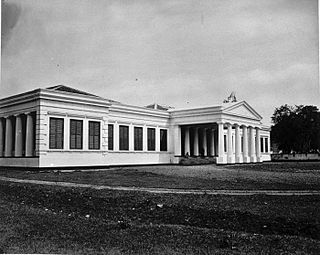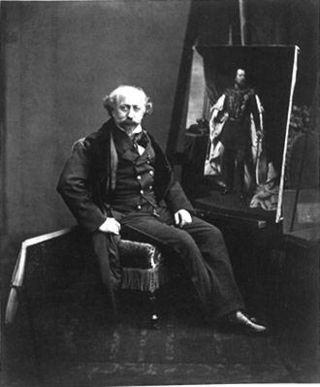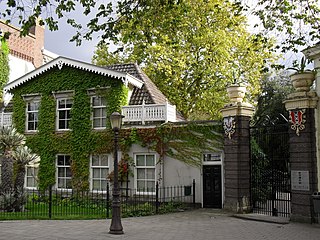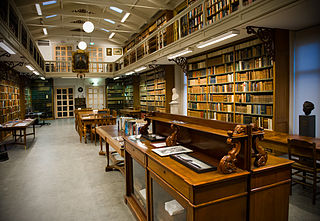
Ethnographic Museum Artis (Dutch: Ethnographisch Museum Artis) was an ethnographic museum in Amsterdam, Netherlands. It was situated at the Artis zoo.

Ethnographic Museum Artis (Dutch: Ethnographisch Museum Artis) was an ethnographic museum in Amsterdam, Netherlands. It was situated at the Artis zoo.
The Amsterdam zoo and ethnographic museum were founded in 1838 by the Royal Zoological Society 'Natura Artis Magistra' (NAM). [1] The Society focused on science in general and on presentation of the Dutch colonial territories in particular. Therefore, not only live exotic animals collected, but also many other zoological material (skeletons and preparations), minerals and ethnographic objects. These collections were housed since 1851 in a Natural History Museum, also called the "Great Museum". It soon grew out of the building and the collections of ethnographic objects were separated from the rest and housed in the nearby building of the 'Society Amicitiae', the 'Little Museum". Eventually, the growing ethnographic collection could no longer be housed at the Society Amicitiae building, and in 1888, on the occasion of the 50th anniversary of the zoo, the ethnographic museum was established in the Volharding ("perseverance") building. [2]
The zoo's ethnographic collection stemmed from the desire to understand creation. The Ethnographisch Museum Artis was the third ethnological museum in the Netherlands. Although it was smaller than the Rijksmuseum and the Wereldmuseum, it was not less important. The collection was gathered by individuals, including government officials from the Dutch colonies, missionaries, agents and travelers, but also by companies and scientific societies. Thus, it contained objects that were collected during early scientific expeditions in Dutch New Guinea such as the Etna expedition. There were artifacts made by indigenous populations as well as models of Dutch factories in Java. [3] Material of the World Exhibition of 1883, which was held in Amsterdam, led to a visit to Artis. Eventually, the museum possessed not only pieces from the Dutch overseas territories, but also from China, Korea, Japan, Africa, and Oceania. While the 19th century Korean objects illustrated human cultural diversity, the gendered collection of jackets, belts, slippers, hats and women's underwear was considered incomplete by today's standards. [4] Officially, the Ethnographic Museum Artis existed until 1910. Volharding became too small to house the many thousands of objects and it became outdated. The entire collection was donated to the Vereeniging Koloniaal Institute, who had a Colonial Museum in Amsterdam near Artis. That Colonial Museum became Tropenmuseum. It took over the collection in 1926. Of the original over 11,000 objects from the Artis collection, a large number decayed, but what remained still represents one of the core collections of the Tropenmuseum. A significant number are permanently exhibited.
A major donor was the linguist Herman Neubronner van der Tuuk. From 1887 to 1902, the collection was managed by curator Cornelis Marinus Pleyte, who wrote a guide. [5] Though it was published by the Society Natura Artis Magistra, Pleyte and his father, the Egyptologist Willem Pleyte, went on to serve on the board of Brill Publishers. [6]

Natura Artis Magistra, commonly known just as Artis, is a zoo and botanical garden in the centre of Amsterdam. It is the oldest zoo in the Netherlands and fifth oldest zoo in the world.

The Tropenmuseum is an ethnographic museum located in Amsterdam, Netherlands, founded in 1864.

The National Museum of Ethnology, is an ethnographic museum in the Netherlands located in the university city of Leiden. As of 2014, the museum, along with the Tropenmuseum in Amsterdam, and the Africa Museum in Berg en Dal, together make up the National Museum of World Cultures.

The Royal Batavian Society of Arts and Sciences was a Dutch learned society in Batavia.

Hendrikus Albertus Lorentz was a Dutch explorer in New Guinea and diplomat in South Africa.

Nicolaas Pieneman was a Dutch painter, art collector, lithographer, and sculptor.
The Etna expedition (1858) was an early policy-oriented exploration of the then virtually unknown south and north coast of Dutch New Guinea, that can also be regarded as the second Dutch scientific expedition to the main island of New Guinea since 1828.

Plantage is a neighbourhood of Amsterdam, Netherlands located in its Centrum borough. It is bordered by the Entrepotdok to the north, Plantage Muidergracht to the east and south and Nieuwe Herengracht to the west. In the centre of the neighbourhood lies the Natura Artis Magistra zoo. It had a population of 1,980 in 2017.

The International Colonial and Export Exhibition was a colonial exhibition held in Amsterdam from May 1 to October 1, 1883. The event drew at least a million visitors and was the first international colonial exhibition, with 28 different nations presenting their colonial trade and wealth.

The Royal Tropical Institute is an applied knowledge institute located in Amsterdam, Netherlands. It is an independent centre of expertise, education, intercultural cooperation and hospitality dedicated to sustainable development.

The Amsterdamse Joffers were a group of women artists who met weekly in Amsterdam at the end of the 19th and beginning of the 20th century. They supported each other in their professional careers. Most of them were students of the Rijksakademie van beeldende kunsten and belonged to the movement of the Amsterdam Impressionists. Each one became a successful artist. As a group they contributed to the social acceptance in the Netherlands of women becoming professional artists.

Amsterdam University Library is the library of the University of Amsterdam (UvA) and the Academic Medical Centre (AMC). The central complex of the Library is in the town centre at Singel, close to Heiligeweg and Koningsplein. The Library's Special Collections are housed nearby at Oude Turfmarkt, next to UvA's Allard Pierson Museum. The Library also has a large book depot in the grounds of the AMC, with over 40.5 kilometers of books and other materials. The foundation Friends of the Library of the University of Amsterdam regularly donates special manuscripts or rare editions to the library collection.

Cornelis Marinus Pleyte was a Dutch museum curator, Dutch East Indies subject-matter expert, teacher, and author. He was notable for his classification work on neolithic Indonesian adzes.

Barend Wijnveld was a Dutch painter.

Artis Bibliotheek is a nineteenth-century library located at Plantage Middenlaan 45 in Amsterdam. Since 2005, the Artis Bibliotheek has been part of the Special Collections at the University of Amsterdam.

The Great Pustaha is a pustaha displayed in the Tropenmuseum of Amsterdam. The name refers to the largest pustaha which was kept in the museum. The official name for the pustaha is simply "pustaha", but for the purpose of distinction, the pustaha is called the Great Pustaha.

Johan Theodorus (Jan) Broekhuijse was a Dutch anthropologist, ethnographer, civil servant and photographer.

The Network of War Collections is a partnership of over 250 archival institutions, museums, remembrance centers and libraries in the Kingdom of the Netherlands, the former Dutch colonial empire, and internationally to bring together scattered collections of resources pertaining to World War II. The network is financed by the Ministry of Health, Welfare and Sport and receives a contribution from the National Fund for Peace, Freedom and Veteran Care.